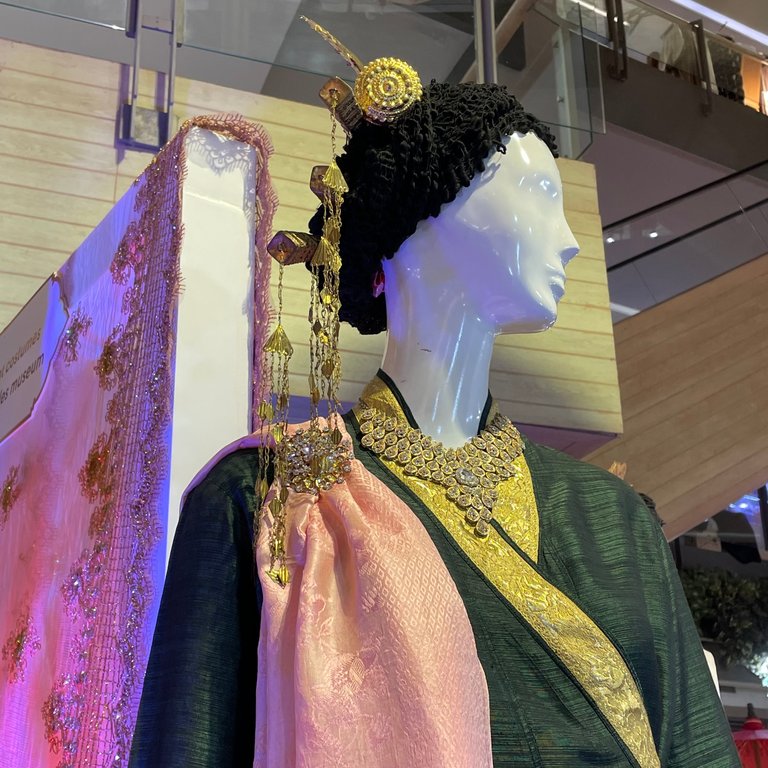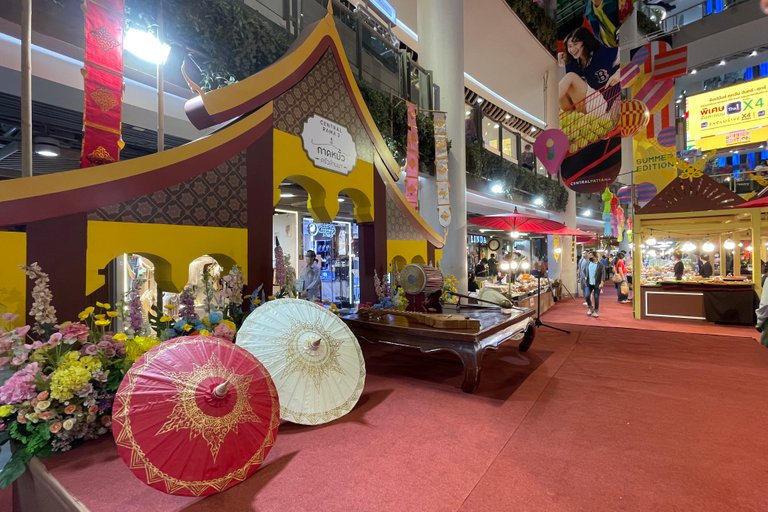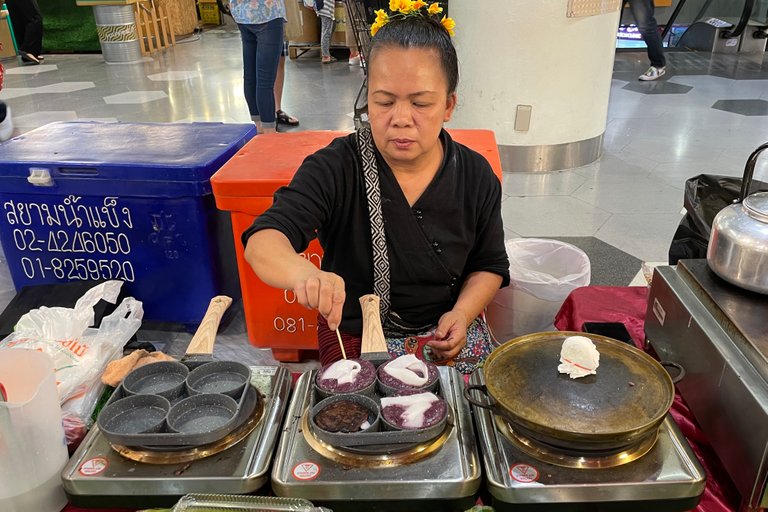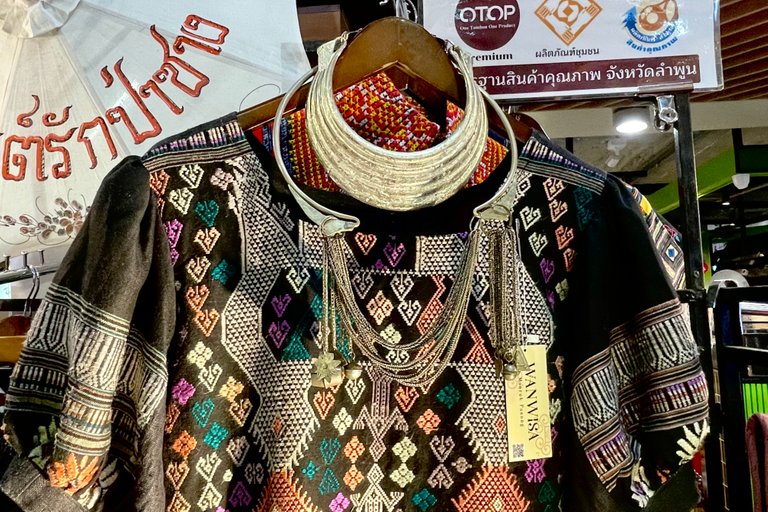During the hot season, the best place to spend the afternoon is a nice air-conditioned shopping mall. I was quite surprised to discover a special weekend market of northern culture at my favourite shopping mall. Many vendors traveled all the way from the northern provinces of Chiengmai and the mountainous areas near the border between Thailand and Laos. I could notice their northern accent and slangs. They also dressed in traditional hand woven clothes which represented their heritage.


The traditional culture of the northern provinces is very different from that in the northeastern part of Thailand. The local northern language sounds much softer with sophisticated melodies. This might be due to the historical setting: the northern provinces used to belong to a very old Lanna Kingdom with long linages of kings and princes. The land florished among intricate palace protocols, arts, cuisine, and language. So, the northern language still sounds very polite and courteous like living in courteous royal surroundings.


These sophisticated lifestyles and heritage are reflected in local textiles, hand woven clothes with complex designs including very intricate decorations in temples. People are very proud of their unique cultural heritage; many northern people still dress in traditional costume and old silver jewelries. They reminded me of some Scottish people in their clans’ tartan patterns. I found the Scottish accent as difficult as our northern accent.


But it’s strange to me that they have very similar signature food item; the Scottish has the haggis while our northerners have ‘sai ouur’. Unfortunately, they don’t have local whisky made from single malt! Perhaps in the past they did some strong and tasty moonshine but these home made brews has out outlawed by those who had the monopoly for producing beer and whisky for domestic consumption and export. They lobbied for monopolistic power and squashed all local wisdom on home made alcoholic drinks.


The northern food is much less spicy than Issan or northeastern food. The former like to cook with coconut cream and milk which make the local chicken noodle curry very tasty. The latter hardly put any coconut milk in their cooking, except for sweets. I prefer the raw and earthy food and ‘rough’ language of the northeastern part. The rawness and unrefined characteristics seem to ground me in reality much faster than the intricacies of sophisticated culture. It takes more effort for me to fit in very refined and courteous settings; I would have to be careful not to be impolite. But most of my old friends have their second homes in Chiengmai as they enjoy the artistic ambience and delicious cuisine of the north.



I walked around the weekend market to survey the northern fast food and sweets. They didn’t have any vegetarian food on offer so I had some mushrooms pies from a nearby bakery. There was a stage with musical performance by old style musicians. The music sounded like a combination of traditional Indian and old Thai instruments mixing together. There were no hill tribe people at the weekend fair, but I caught a lady in hilltribe costume.



The atmosphere was very nice and pleasant with curious visitors browsing around various stalls. I was more interested in the antique textiles and costumes borrowed from the museum for the exhibition. Some pieces of cloth are over three hundred years old. The museum did manage to protect these precious and historical fabrics very well. The models and all costumes on show were transported from the museum in Chiengmai. I was very happy to enjoy these antiques without having to pay any entrance fee or traveling cost.




Older generations of people had so much patience and good memories for all the difficult patterns in weaving a piece of traditional cloth. This knowledge was passed from one generation to the next by learning to weave everyday without any notes or instructions. Perhaps, having no televisions and mobile phones helped to maintain good brains with long lasting memories. Some of the textile patterns and colours looked very modern to me. But on closer inspection, they were over 150 years old! The embroideries were laboriously done by hands. These people had the patience and dedication of elephants.




We would never see old textile with embroidery in northeastern part of Thailand. The unique characteristics of woven textiles were the complicated patterns and specially designed looms which made it possible to insert different coloured threads on various locations. The cloth would be much heavier and thicker which made these clothes very durable. In the past, each family would have its own unique patterns like a signature of the family. A young lady had to weave at least three pieces of cloth before the wedding. So, the bride would have three new costumes for her wedding ceremony.




The hill tribe people were very well known for their unique style of embroidery and patchwork stitching. Lots of these antique clothes have been transformed into wall hangings in museums and became collectibles. These were mostly heavy cotton fabrics with mixtures of hemp. Some hand stitching works remindedme of old Chinese art work. These people worked at very fine details using sunlight and candle light at night. So, I reckoned they must have become short sighted at s young age.




Ethnic clothes are never popular among city people as they look very drape and simple. City people prefer shiny textures with luxurious look. Western designers’ brands would make more money in big cities. But antique clothes and costumes have become collectors’ items which are sought after by a group of serious collectors. I have met one collector who would travel to Laos and up the mountains in search of family heirlooms among villagers. However the collectors woujd have to know how to preserve these old clothes so that they are always pristine and looking new.




I never imagined that I would happen to know two collectors of antique fabric and cloth. They opened my eyes to the relationship between woven cloth, family and cultural context. One day when all the weaving looms disappeared and nobody knew how to make their own cloth anymore, the world of these hill tribe and northern peoples would have been lost through the passage of time and changes of reality. All the old family stories would become faint memories of long gone days. I would no longer be blogging on this earthly dimension any more. Shall we ever meet again somewhere, somehow?




Wishing you peace, good health and prosperity.
Stay strong and cheerful.
#marketfriday created by @dswigle.
Cheingmai is such a popular spot for Westerners, they love it! This was such an interesting post on the textiles and differences within Thailand. I love the different patterns, weaves, and the upscale to the more rustic clothing. I actually don't have a preference on which I like best, they both are beautiful and function in their own surroundings.
You made such a wonderful post this time, again. As usual. I loved it and the pictures are awesome! Thank you for taking us!~
#MarketFriday began as a way to reach out across the globe and learn about different cultures through their markets, especially local markets and farmers' markets, and eventually branched out and evolved over time from straight shopping to a cultural affair as it highlights how we differ and then again, how much we are alike. We have become a melting pot of culture, but it is still the Rituals, Festivals, food, architecture, and even your language/languages that separate us... Along with the fact that these things are normal for us. There are unwritten rules that rule our social behaviors. I see this as allowing for increased tolerance between cultures and nations, and opportunities to come together on an even playing ground. A strong culture can be beneficial to a country as it promotes unity, especially during a crisis, peaceful debate, and open dialogue. I have learned so much about all of you and it has been an amazing experience. I can only hope that learning about each other can help us work together for a peaceful world.
Thank you for being a part of #MarketFriday
#MarketFriday loves you!
Thank you so much for your encouraging words and very kind comments. Glad that you did enjoy the textile exhibition.
Have a wonderful weekend.
Yay! 🤗
Your content has been boosted with Ecency Points
Use Ecency daily to boost your growth on platform!
Support Ecency
Vote for new Proposal
Delegate HP and earn more, by @kaminchan.
Your kind support is much appreciated.
Awesome insights my friend, about the north of Thailand. Perhaps I should visit there next time and not only the beautiful tourist beaches and islands.
Do you know of the ancient history of Thailand that seems to be connected to the ancient Hindu culture, better known as the Vedic culture? I saw Hindu sculptures depicting the Vedic stories when I passed through Bangkok airport a few years ago on my first trip.
Oh! You should visit Chiengmai and Chiengrai one day, just to see the old decorative temples and a hike on the mountains.
Some provinces in Thailand still have perfect Hindu sandstone buildings and temples. People would visit some old temples to see the sunrise through all the doors on summer solstice.
Wow this is awesome to hear, thank you for the info and advice. I am inspired to put these northern regions on my travel list. I'll search out the old Hindu temples.
You would like this place.
https://www.renown-travel.com/khmertemples/phimai.html
Pretty market.
Thanks. Hope you won’t have to work too hard! Those projects are doing very well for many people. You’ll always have good memories of the good old days in the future.
Thanks many times.